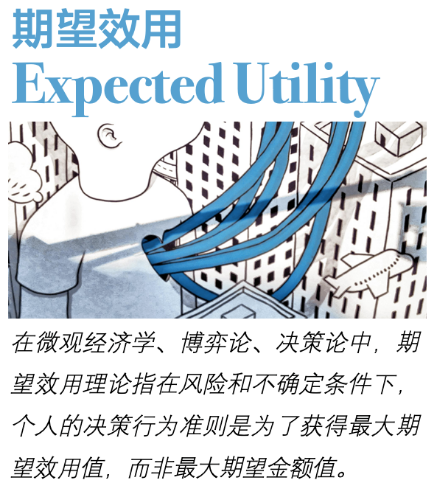
「释义」
在微观经济学、博弈论、决策论中,期望效用理论指在风险和不确定条件下,个人的决策行为准则是为了获得最大期望效用值,而非最大期望金额值。
这个理论最早在1738年由丹尼尔·伯努利提出,用于解释赌博和保险中的期望值。
冯·纽曼-摩根斯坦效用定理提出一个有理性的人应该如何选择的公式。
「应用场景」
“互相保证毁灭”这一术语的创始人、数学家约翰·冯·诺依曼以“期望效用”理论将当时的研究迅速推入决策领域。1944年,他与经济学家奥斯卡·摩根斯坦合作撰写的重要著作《博弈论与经济行为》第一章便概述了期望效用是想象事件与概率相结合的产物。期望结果效用值乘以该结果发生的概率,与自然发生所能得到的利益效用值及其概率乘积相比,便可得出期望效用值以指导决策。
The mathematician John von Neumann, who coined the term mutual assured destruction, helped jump-start research into decision making with his notion of “expected utility.” As outlined in the first chapter of his landmark 1944 book Theory of Games and Economic Behavior, written with the economist Oskar Morgenstern, expected utility is what results from combining imagined events with probabilities. Multiply the likelihood of a result against the gains that would accrue, and you get a number, expected utility, to guide your decisions.
冯·诺依曼和摩根斯坦的期望效用理论框架甫一提出,经济学家便将之视为理性行为模型和对人类决策实际过程的描述。“经济人”应当是理性生物,既然如今的理性概念内涵包括以某种一致的方法评估概率,那么经济人也应该做到这一点。
Almost as soon as von Neumann and Morgenstern outlined their theory of expected utility, economists began adopting it not just as a model of rational behavior but as a description of how people actually make decisions. “Economic man” was supposed to be a rational creature; since rationality now included assessing probabilities in a consistent way, economic man could be expected to do that, too.
《从“经济人”到行为经济学》 贾斯廷·福克斯
2015年5月刊 “From “Economic Man” to Behavioral Economics” by Justin Fox
编辑:马冰仑




